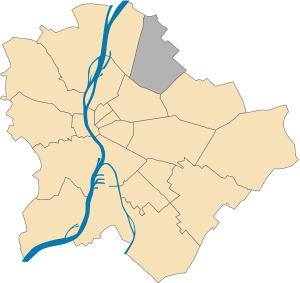The 15th District of Budapest: A Community-Driven, Modern Experience
Located in the northwestern part of Budapest, the 15th district is a contemporary area that blends community living with urban conveniences. Whether you’re a food enthusiast, a nature lover, or someone interested in local culture, the 15th district offers a different taste of Budapest that every tourist should experience.
Introduction
The 15th district of Budapest is a lesser-known but increasingly popular area with a strong sense of community and many modern amenities. From the vast green spaces to its bustling markets, this district offers tourists a chance to witness Budapest’s urban development while still providing a glimpse into everyday Hungarian life.
Location

Situated in the northeastern quadrant of Budapest, this area is strategically bordered by several key locations. To the north lies Fót, Csömör is to the northeast, District XVI is in the southeast, District XIV is to the southwest, and District IV forms the western boundary.
Main Roads and Intersections:
- Access to the M3 Motorway: This major highway provides quick and convenient travel to various parts of Hungary, making it a vital artery for local and long-distance travel.
- The Main Road: As a central thoroughfare, this road is crucial for local commuting and connects several key areas within the district.
- Szentmihályi út and Nyírpalota út: These are significant routes that facilitate movement across the district, linking residential and commercial zones.
- Kolozsvár Street and Rákos út: These other essential routes contribute to the local road network, providing additional avenues for travel and commerce.
- Main Square, Hubay Jenő Square, Stárai Mihály Square, and Kossuth Street are focal points within the district, often bustling with activity and serving as communal spaces for residents.
Some of the district’s primary routes, such as the Árpád út flyover, Illyés Gyula utca, and Régi Fóti út, along with Külső Fóti út, are integral parts of the national road network. Specifically, sections of the 2102 road within the capital city connect through Fót and Veresegyháza to Galgamácsa. Additionally, a new road constructed to alleviate congestion on the Rákospalotai border road is part of the 21 105 bypass, linking the district with Csömör within the city limits.
The area’s well-designed road network and strategic location make it a key transport hub, facilitating easy access to both the heart of Budapest and outlying regions. This robust infrastructure enhances the district’s appeal as a convenient and accessible place to live, work, and visit.
Geography
Situated in the northwestern part of the city, the 15th district is predominantly flat, featuring several parks and recreational areas. The district is well-connected to the rest of the city, making it an ideal location for tourists who want a peaceful stay without being far from the main attractions.
Landmarks
While not as landmark-dense as other districts, the 15th has its unique attractions:
- Szentmihályi Street Market: Known for its fresh produce and Hungarian delicacies, it’s a must-visit for foodies.
- Rákospatak: A stream that meanders through the district, offering a scenic natural setting.
History
Nestled along the Szilas stream and perched atop a hill, the village of Nyír, later renamed Palota, boasts a history that stretches back to the medieval era. Its oldest surviving architectural feature is the ruins of a church built around the year 1200. These ruins now form the foundation of the Roman Catholic monument church on Kossuth Street, which was constructed in 1735. Adjacent to this church, archaeologists have unearthed a cemetery with graves dating back to the 14th through 17th centuries.
Ownership of Palota has changed hands multiple times over the centuries. The first known proprietor was Prince Lóránd, a Buda judge elected in 1347. His family retained control of the village until the 15th century. By 1638, the village had become the property of the Újfalusyak family. Throughout periods of upheaval, such as the expulsion of the Turks and the Rákóczi War of Independence, the settlement faced depopulation but always managed to recover. Ownership shifted again in 1749 to the Fekete family of Galántha and, following their financial decline, passed to the Károlyi family in the early 19th century.
Significant changes occurred in the mid-20th century when the county town of Rákospalota and the Pestújhely district were incorporated into Budapest on January 1, 1950. This annexation led to the formation of the current district. Meanwhile, Istvántelek, which had been part of Rákospalota, was integrated into the newly formed 4th district originating from Újpest.
A major development took place between 1969 and 1978 with the construction of Újpalota, one of Budapest’s largest housing estates. This expansive residential area marked a significant chapter in the district’s evolution, adding a modern layer to its rich historical tapestry.
Today, the area stands as a testament to its resilient and diverse history, from its medieval roots to its modern-day developments, making it a fascinating locale that encapsulates Budapest’s broader historical and cultural narratives.
Education
The district is home to several schools, including bilingual institutions, making it an educational hub with a diverse student body. For tourists traveling with family, this implies that the area is child-friendly, with many learning opportunities.
Museums
While the 15th district may not have as many museums as other areas, the existing ones focus on specific interests:
- Óhegy Park’s Outdoor Sculpture Gallery: An open-air gallery showcasing various sculptures.
Twin Towns
The district has several twin towns, including Băicoi in Romania and Debrzno in Poland. These relationships foster cultural exchange and contribute to the community spirit for which the 15th district is famous.
Google Maps of Rákospalota, Újpalota, Pestújhely (District 15)
Conclusion
If you’re looking to experience a different side of Budapest—one that’s community-focused, less touristy, and more in tune with modern urban life—then the 15th district is the place to be. Its lesser-known attractions, like the Szentmihályi Street Market and the Rákospatak stream, offer a break from the crowds, allowing tourists to enjoy Budapest in a more relaxed and authentic setting.